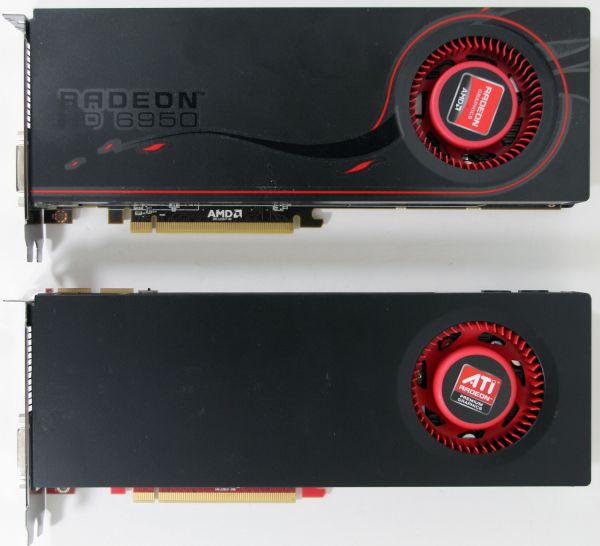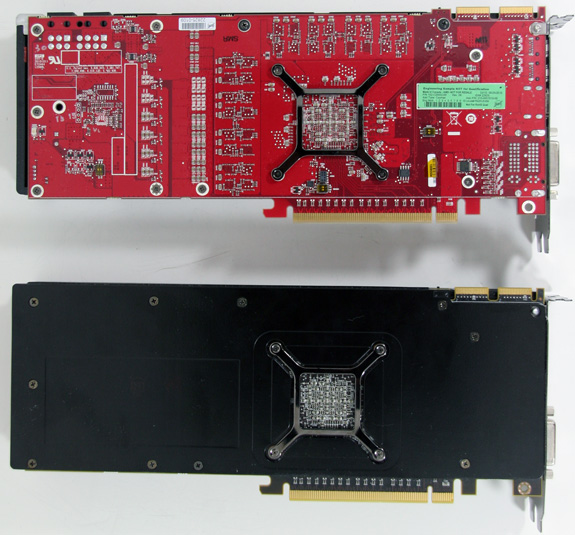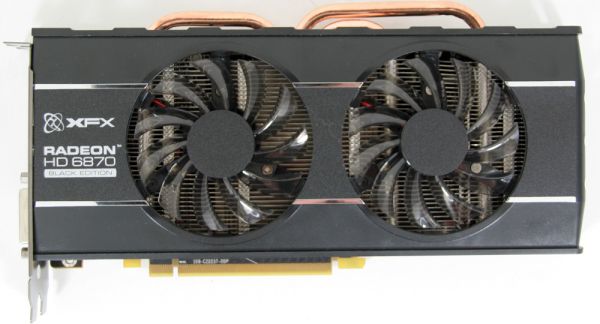AMD’s GTX 560 Ti Counter-Offensive: Radeon HD 6950 1GB & XFX’s Radeon HD 6870 Black Edition
by Ryan Smith on January 25, 2011 12:20 PM ESTMeet The Radeon HD 6950 1GB and XFX Radeon HD 6870 Black Edition
We’ll start our look at today’s cards with the headliner: AMD’s Radeon HD 6950 1GB. As we’ve previously established our 6950 is an engineering sample – perhaps an early one – so there’s not much to look at. Save for the kind of cosmetic defects you’d expect on an engineering sample, it’s for all practical purposes identical to the production 6950 2GB, and that’s intentional. AMD set out to make the 6950 1GB identical to the 6950 2GB other than the use of lower capacity GDDR5 chips, and this is what they have accomplished.

Top: 6950 2GB. Bottom: 6950 1GB Engineering Sample

Top: 6950 1GB Engineering Sample. Bottom: 6950 2GB
Since producing a 1GB card involves little more than replacing 2Gb memory chips with 1Gb memory chips, the true design innovations are going to come from AMD’s partners. Sapphire already has a 6950 1GB out with a custom cooler, and as AMD’s other partners get situated with 1GB cards we expect to see much of the same with them.
One item worth noting is that because our card is based on the reference design, it includes the BIOS switch at the top of the card. This means reference-based 1GB cards are going to have the same BIOS failsafe in them – however suitable BIOSes for the unlockers among you are another matter. Without some BIOS hacking (and possibly more), existing 6970 BIOSes are unsuitable as they’re meant for 2GB cards. Until such a time comes where a 6970 1GB BIOS can be developed, the 6950 1GB is not going to be a good card for unlocking. For the time being unlockers are going to want to stick to 2GB cards.
The Radeon HD 6950 1GB is launching with an MSRP of $259. At this time you can find reference-style 2GB cards for as little as $269, making the 1GB cards a rather simple $10 trade-off if you don’t mind mail-in rebates.
XFX Radeon HD 6870 Black Edition
Our second card of the day is XFX’s 2nd generation Radeon HD 6870 Black Edition (687A-ZDBC), the card that AMD originally proposed as the GTX 560 Ti’s competitor. Clocked at 940MHz core and 1150MHz (4.6Gbps data rate) memory, it runs at 40Mhz (4%) core and a 100MHz (9%) memory over the reference 6870. Overall this is a mild overclock, particularly as the 6870 is core-bound as opposed to memory-bound most of the time.
With such a mild overclock we had little reason to pay attention to the card, particularly once we completed our GTX 560 Ti benchmarking and saw that it was 10-20% faster than the stock-clocked 6870. Indeed it wasn’t until we tested the card that we saw something that grabbed our attention. Or perhaps I should say heard.
At the risk of spoiling the rest of our article, this card is for all practical purposes silent. At idle it’s only as loud as the noise floor of our GPU testbed, and at load – even under Furmark – it’s the same story. We measured 41.4dB at both idle and load, making it the quietest actively cooled mid-range card we have ever tested in our existing rig. Even the remarkably quiet GTX 460 can’t hold its ground to the 6870 Black Edition, it’s that quiet.
So what’s XFX’s secret? It’s much the same story as with the GTX 460. While the 6870 reference design uses a blower XFX is using an open-air cooler, specifically a double-fan cooler with 3 copper heatpipes that’s very similar to MSI’s Twin Frozor and Gigabyte’s Super Overclock cooler. Open-air coolers are already capable of being much quieter than blowers, and when done correctly a double-fan arrangement can be quieter than driving a single fan at higher speeds. Combining this highly effective cooler with the 6870’s Black Edition’s low TDP (~160W) results in a very quiet card that by all indications cannot be beaten at this point in time.
Rounding out the package, there are no real meaningful extras to discuss. Aside from some trinkets (stickers, case badges, etc), the only other piece of hardware in the box is a short CrossFire bridge. XFX has kept it simple: the only things that really matter are the card and XFX’s lifetime warranty.
The Radeon HD 6870 Black Edition doesn’t have a set MSRP, but it’s currently available for around $229 with a mail-in rebate, making it roughly $10 more expensive than a stock-clocked card. Or compared to XFX’s lineup, the non-Black Edition version of this card is a mere $4 less at $225; so you’re looking at a $4 factory overclock and $6 for a supurb custom cooler.












111 Comments
View All Comments
JPForums - Tuesday, January 25, 2011 - link
It looks to me like the 560 Ti only has the edge over the 6950 1GB tessellation with high factors. Even the 6870 bests the 560 Ti in the DirectX 11 Tessellation Sample test at the medium setting. See anandtech's 560 Ti launch article.What I find even more interesting is that when you consider only the higher resolutions, the 6950 seems to be superior to the 560 Ti. I realize most people still use lower resolutions, but it doesn't make sense to judge between the potential of two cards at any resolutions that both can produce more than playable frame rates at the settings in question. This creates a misleading conclusion in situations where the winner reverses at higher resolutions. Hawx, for instance, shows that the 560 Ti has clearly superior frames rates at lower resolutions where the 6950 scales much better and edges it out at 2560x1600. Neither dip below 80 fps, so you can't really say the gameplay differs, however, it appears the 6950 is the one that has the muscle when it counts. Battlefield BC2 shows a similar reversal (reference anandtech's 560 Ti launch article). Of course, there are situations where nVidia turns tables at higher resolutions as well, they just aren't present in anandtech's launch article (unless I missed it).
softdrinkviking - Wednesday, January 26, 2011 - link
I believe that Ryan replied in the comments for the 560 Ti card to a commentor who inquired about the repeatability of FPS results with the 6950 1GB while playing Crisis at high resolutions, and it may pertain to your argument.He said that the results are "highly variable."
If you are going by the avarage frame rate, and only at high res., the 6950 looks better than the 560 Ti but...
Perhaps the 560 Ti produces more consistant results than the 6950?
JPForums - Thursday, January 27, 2011 - link
Ryan does a really good job with articles, so I don't want to come off as bashing him. However, if that was a major concern, I really wish he would have mentioned it in the article. Taking it a step further, he could post charts with min, max, and average. Alternately, if he felt particularly generous, he could post a graph of the frame rates over the course of the benchmark for the cases where one companies cards are less consistent than the others. Of course, that would be a lot of work to do for every benchmark and would incur unnecessary delays in getting the articles out. I would only include such charts/graphs to back myself up when I felt it changed the outcome. That said, even if these never show up, I'll still enjoy reading Ryan's articles.On a personal note, the idea that the GTX560 Ti may be more consistent than the HD6950 makes me feel better about my decisions to purchase a GTX460 and GTX470 given the similarities in architecture. That said, I haven't noticed abnormal inconsistencies in frame rate with the HD6870 I bought as a Home Theater/Gaming card for the living room. I hope any inconsistencies in the frame rate of the HD6950 are driver related and not architectural, or we may loose some of the wonderful competition that has characterized the graphics market as of late.
britjh22 - Tuesday, January 25, 2011 - link
I see the 6950 pricing as sort of strange. Currently you pay $10 after MIR's to move up to 2 GB. A small price for a sometimes useful boost. But if you take unlocking into consideration, the ability to unlock with the 2Gb version, and not with the 1Gb, I'd say that's quite a massive difference.Of course, I don't have a good feel about the success rate of the 6950 to 6970 unlock, or what % of cards it's possible with, but the pricing seems quite strange in that light.
Oh, and let's see dropping prices on a 6870 please!
MeanBruce - Tuesday, January 25, 2011 - link
Dude, 6870s are as low as $199- right now over at Newegg at least for the Sapphire, yup!buildingblock - Tuesday, January 25, 2011 - link
My local hardware dealer has several GTX 560s in stock today, including 900Mhz factory overclocked models. The Gigabyte Super OC 1Gb is listed and promised soon.... But the 1Gb AMD 6950 - no sign whatever. I see elsewhere references to the fact that this card is likely to be a short run special by AMD as a GTX 560 launch spoiler, and that certainly seems to be the case. I look forward to the Anandtech review of factory overclocked GTX 560s at some point.Ryan Smith - Tuesday, January 25, 2011 - link
At this point the only place you're going to find them is at Newegg and other e-tailers. With the launch pulled in by this much this soon, they won't be on B&M store shelves yet. This isn't all that rare, in fact I would say it's much more rare to find newly launched cards available in B&M stores.TonyB - Tuesday, January 25, 2011 - link
Competition is a wonderful thing ain't it?prdola0 - Tuesday, January 25, 2011 - link
Hello Ryan,after such a nice review of the GTX560 Ti, I am quite disappointed that you included the overclocked HD6870 in this test. First, after you reviewed the GTX460 and included an OCed model, you get bashed by AMD fans crying foul. So you ask readers to say if it's ok to include an OCed model and from the count of posts you draw a conclusion not to include OCed models. I was suprised then, because measuring such a thing by mere post count is quite inadequate, considering that unhappy people usually shout the loudest and the happy ones don't need to. So of course you'd have more posts against it, no surprise there. But then I kinda let it go. However, seeing now that you did include an OCed model again, but this time something that is not so common, unlike OCed GTX460, I was very upset. Why didn't you review the OCed Gigabyte or Asus GTX560 cards? And considering reviews from other sides and the great results the OCed cards have, will you prepare a new review article dedicated to the OCed GTX560 to fix this bias?
Here is where I remember how I though saying things like "I am not going to visit this site anymore" is quite silly after the OCed GTX460 case. But seeing how you turn 180 for reasons unknown to me, I must say the very same thing.
Best regards,
Prdola
Aikouka - Tuesday, January 25, 2011 - link
I really don't get the persistent whining from some of you over this topic. You're so "hurt" over Ryan spending *his* time on benchmarking a card that was *originally billed as the 560 Ti's competitor*... it's completely inane.If you don't think it should be considered, then simply ignore the card in the charts, and you'll get what you consider to be a pure "OC free" comparison.
As for my stance on it, if something is purchased off the shelf **with the configuration that was tested**, then it's fine to put it on there in a normal (i.e. not overclocking specific) article and/or section.